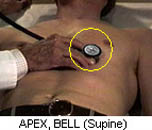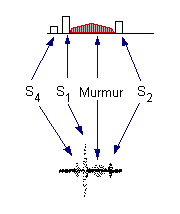

Summary:
This patient had a trans-thoracic echocardiogram which showed evidence of asymmetric septal hypertrophy with mild subaortic stenosis.
Lessons:
- At times it is extremely difficult to differentiate the systolic murmur of hypertrophic cardiomyopathy from the innocent murmur which is so common in athletes.
- A helpful clue is demonstrated here. Valsalva usually diminishes the loudness of an
innocent murmur but usually increases the loudness of the murmur of hypertrophic
obstructive cardiomyopathy.
Synonyms and Terminology of Hypertrophic Cardiomyopathy
- Hypertrophic cardiomyopathy has several synonyms including:
- muscular sub-aortic stenosis,
- idiopathic hypertrophic subaortic stenosis (abbreviated IHSS), and
- hypertrophic obstructive cardiomyopathy (HOCM)
The term "hypertrophic cardiomyopathy" (HCM) is now most widely used.
However, in this patient, the term hypertrophic obstructive cardiomyopathy is most accurate since his systolic murmur suggests subaortic obstruction.
- Having the patient stand will cause the same effect for the same reasons. Both standing and Valsalva decrease venous return which leads to reduction of the size of the left ventricle. This increases the degree of subaortic obstruction and intensifies the murmur of hypertrophic obstructive cardiomyopathy.
- The apical impulse and S4 which suggested possible LVH were also helpful here, as was the location of the maximum intensity of murmur (which was between the apex and pulmonic area).
